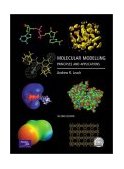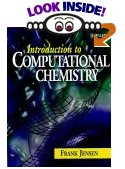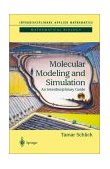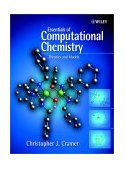


|
Molecular
Modelling: Principles & Applications (2nd
Edition) by Andrew Leach
Book Info
Provides a broad introduction to the techniques
employed in molecular modeling and computational
chemistry. The first part covers quantum mechanics
and the second deals with the energy models such as
minimization, molecular dynamics and Monte Carlo
simulations. Paper. --This text refers to an out of
print or unavailable edition of this title.
From the Back Cover
This important new edition is for postgraduate
students of chemistry, medicinal chemistry and
biochemistry studying molecular modelling and
computational chemistry. The book will also be
useful for researchers in academia and in the
pharmaceutical and chemical industries and those
teaching or attending courses in molecular
modelling.
The new edition provides background theory in
the techniques of molecular modelling, illustrated
with applications from the physical, chemical and
biological...

|
|
|
|

|
Introduction
to Computational Chemistry by Frank
Jensen
From Book News, Inc.
Provides an account of the fundamental
principals underlying different methods, ranging
from classical to sophisticated quantum models.
Although the main focus is on molecular structures
and energetics, the text also covers molecular
properties, dynamical aspects, relativistic
methods, and qualitative models. Some understanding
of introductory quantum mechanics and elementary
mathematics is assumed. Book News, Inc.®,
Portland, OR --This text refers to the Hardcover
edition.
Book Description
Introduction to Computational Chemistry Frank
Jensen Odense University, Denmark Computational
chemistry is a rapidly emerging and developing
area, combining theoretical models with computers
to investigate a variety of chemical phenomena.
Increasingly applied throughout chemistry,
computational methods are becoming an integral part
of modern chemical research. Introduction to
Computational Chemistry provides a comprehensive
account of the fundamental principles underlying
different methods,... read more

|
|
|
|

|
Molecular
Modeling and Simulation by Tamar Schlick
(Hardcover)
Book Info
This book evolved from an interdisciplinary
graduate course entitled Molecular Modeling
developed at NYU. Its primary goal is to stimulate
excitement for molecular modeling research while
introducing readers to the wide range of
biomolecular problems being solved by computational
techniques and tools.
Book Description
This book evolved from an interdisciplinary
graduate course entitled Molecular Modeling
developed at New York University. Its primary goal
is to stimulate excitement for molecular modeling
research while introducing readers to the wide
range of biomolecular problems being solved by
computational techniques and to those computational
tools. The book is intended for beginning graduate
students in medical schools and scientific fields
such as biology, chemistry, physics, mathematics,
and computer science. Other scientists who wish to
enter, or become familiar, with the field of
biomolecular modeling and simulation may also
benefit from the broad coverage of problems and
approaches.
The book surveys three broad areas: biomolecular
structure and modeling: current problems and state
of computations; molecular mechanics: force field
origin, composition, and evaluation techniques; and
simulation methods: geometry optimization, Monte
Carlo, and molecular dynamics approaches.
Appendices featuring homework assignments, reading
lists, and other information useful for teaching
molecular modeling complement the material in the
main text. Extensive use of world wide web
resources is encouraged, and additional course and
text information may be found on a supplementary
website.
Some praise for Tamar Schlick's "Molecular
Modeling and Simulation: An Interdisciplinary
Guide":"The interdisciplinary structural biology
community has waited long for a book of this kind
which provides an excellent introduction to
molecular modeling."-Harold A. Scheraga, Cornell
University"A uniquely valuable introduction to the
modeling of biomolecular structure and dynamics. A
rigorous and up-to-date treatment of the
foundations, enlivened by engaging anecdotes and
historical notes."-J. Andrew McCammon, Howard
Hughes Medical Institute, University of California
at San Diego"I am often asked by physicists,
mathematicians and engineers to recommend a book
that would be useful to get them started in
computational molecular biology. I am also often
approached by my colleagues in computational
biology to recommend a solid textbook for a
graduate course in the area. Tamar Schlick has
written the book that I will be recommending to
both groups. Tamar has done an amazing job in
writing a book that is both suitably accessible for
beginners, and suitably rigorous for experts."-J.J.
Collins, Boston University

|
|
|
|

|
Essentials of
Computational Chemistry : Theories and Models by
Christopher J. Cramer (Author) (Paperback)
5 Star Review
Cramers' book is an excellent introduction to
the field of computational chemistry. The book is
organized in 15 chapters. Chapter 1 gives you a
general overview on the interplay between Theory,
Computation and Modeling. The next two chapters are
devoted to molecular mechanics (ch. 2) and to
simulation of molecular ensembles (ch. 3), namely
molecular dynamics and Monte Carlo methods, which
are necessary for a better understanding of later
chapters on condensed phases (see ch. 11 and 12).
Note, however, that quantum chemical methods are
the main subject of this book and if you want to
learn more about molecular simulation (i.e. force
field-based methods), you will need to consult
books like Frenkel & Smit's "Understanding
Molecular Simulation" or else. Chapter 4 lays the
foundations of molecular orbital (MO) theory and is
closely followed by ch. 5 (semiempirical methods)
and 6 (ab initio Hartree-Fock MO method). Electron
correlation methods are discussed in ch. 7 while
ch. 8 is devoted to density functional theory
(DFT), whose merits and demerits in solving
molecular problems are being compared to MO theory
(cf. paragraph 8.5). The remaining six chapters
discuss about charge distribution and spectroscopic
properties (ch. 9), thermodynamic properties (ch.
10), implicit (ch. 11) and explicit (ch. 12) models
for condensed phases, hybrid QM/MM methods (ch.
13), excited electronic states (ch. 14), and
adiabatic reaction dynamics (ch. 15). At first
sight, the book contains a lot of good written
text, meaning that the author has placed special
care in writing a book for beginners. This,
however, does not mean that more experienced person
should not consult/read the book. On the contrary,
the expert may refresh/integrate his or her
knowledge by selecting specific chapters, each
sufficiently self-contained. A praiseworthy aspect
of this book is seen at the end of each chapter
where you will find a "Case study", showing how the
learned concepts can be exploited to solve real
chemical problems, followed by the "suggested
readings" and "references" sections. I rated this
book with five stars since it is clearly written
and well organized. This book's brother is Jensen's
"Introduction to Computational Chemistry", which
should be consulted in your next learning step.

|
|
|
|

|
The Art of
Molecular Dynamics Simulation by Dennis Rapaport
(Author) (Paperback)
Book Description
The extremely powerful technique of molecular
dynamics simulation involves solving the classical
many-body problem in contexts relevant to the study
of matter at the atomistic level. Since there is no
alternative approach capable of handling this
extremely broad range of problems at the required
level of detail, molecular dynamics methods have
proved themselves indispensable in both pure and
applied research. This book is a blend of tutorial
and recipe collection, providing both an
introduction to the subject for beginners and a
reference manual for the more experienced
practitioner. It is organized as a series of case
studies that take the reader through each of the
steps from formulating the problem, developing the
necessary software, and then using the programs to
make actual measurements. The second edition of the
book includes a substantial amount of new material
as well as completely rewritten software.

|
|
|
|

|
Computational
Chemistry (Oxford Chemistry Primers, 29) by Guy H.
Grant, et al (Paperback)
Book Description
The uses of computers in chemistry are many and
varied, from the modelling of solid state systems
to the design of complex molecules which can be
used as drugs. This text provides an introduction
to the many methods currently used by practising
computational chemists and shows the value of
computers in modern chemical research. The authors
describe the various computational techniques
available and explain how they can be applied to
single molecules, to assemblies of molecules, and
to molecules undergoing reaction. An introductory
chapter outlines the hardware and software
available, and looks at some applications and
developments. Subsequent chapters cover quantum
mechanics, molecular mechanics, statistical
mechanics, the modelling of biomolecules, and drug
design. While emphasizing the use of computers to
model biological systems, the authors explain how
the methods can be applied to a wide range of
chemical problems.
Synopsis
The application of computing technology to
chemical research ranges from the modelling of
solid state systems to the design of complex
molecules which can be used as drugs. This primer
provides an introduction to the many methods
currently used by practising computational chemists
and shows the value of computers in modern chemical
research. The authors describe the various
computational techniques available and explain how
they can be applied to single molecules, to
assemblies of molecules, and... read more

|
|
|
|

|
Introduction
to Protein Structure by Carl-Ivar Branden, John
Tooze (Contributor) (Paperback)
From Book News, Inc.
Illustrates (in clear color diagrams) and
explains for both biologists and chemists the
structural and functional logic that has emerged
from the latest accumulated data on protein
structures. Annotation copyright Book News, Inc.
Portland, Or.
5 Star Review
This book was a pleasant surprise in almost
every respect. I found it a gentle, clear
exposition of material that can be hugely
complicated. The text works upwards from amino
acids, the building blocks, through the
interactions of shape and chemical affinity, to
views of proteins in action. By the time they
appear, muscle fibers and virus capsules follow
naturally from the discussion. This gives simple,
concise descriptions of how proteins' shape emerge
from its sequence. It goes on to describe protein
control of DNA, to explain virus and muscle
structure, and to hint at modern drug design.
'Protein Structure' requires some background in
organic chemistry and in the ideas of molecular
genetics. For example, you should already be
familiar with steric hindrance and with the idea of
regulatory regions in DNA. Branden and Tooze reward
the prepared reader with a well-considered series
of discussions. These include enzyme action,
photosynthesis, virus self-assembly, muscle fibers,
DNA binding, and more. I had never seen an actual
chain of chemical events that turn light into
usable chemical energy. This book stepped through
it (for a bacterium, at least) in just few
paragraphs and drawings. But the whole book is like
that - it sustains a remarkable density of
information, always in a very readable style.
The text is laid out in a simple and appealing
way, and is profusely illustrated. The illustration
is one of this book's wonderful strengths. Almost
all of the discussion is carried in diagrams as
well as in words, and the authors freely use as
many different diagrams as needed to make each idea
understandable. The illustration style is simple
and consistent; most drawings use one of three or
four conventions for describing proteins. Almost
all of the illustrations seem to be hand-drawn with
colored pencil. Still, the corpus of illsutrations
is among the most communicative I have seen in any
book. Artists aspiring to illustrate science (or to
communicate any idea) should read Tufte, then treat
this book as a uniquely successful case study.
My only complaint about this book had to do with
the quality of its printing. A few pages in my copy
have bad register, colors are not consistent from
page to page, and the one major photograph is
weirdly over-sharpened. I must also admit that I do
not need a deep knowledge of protein structure and
function - I scanned the book quickly, and read
only parts with care. The book repaid that effort
richly, and I expect that it will reward more
careful readers even more. I'm not a biochemist,
but I strongly recommend 'Protein Structure' to
anyone at all interested in the topic. --This text
refers to the Paperback edition

|
|
|
|
|
© 2003 Seascape
Learning, LLC. All Trademarks are the property of
respective owners
|
|

